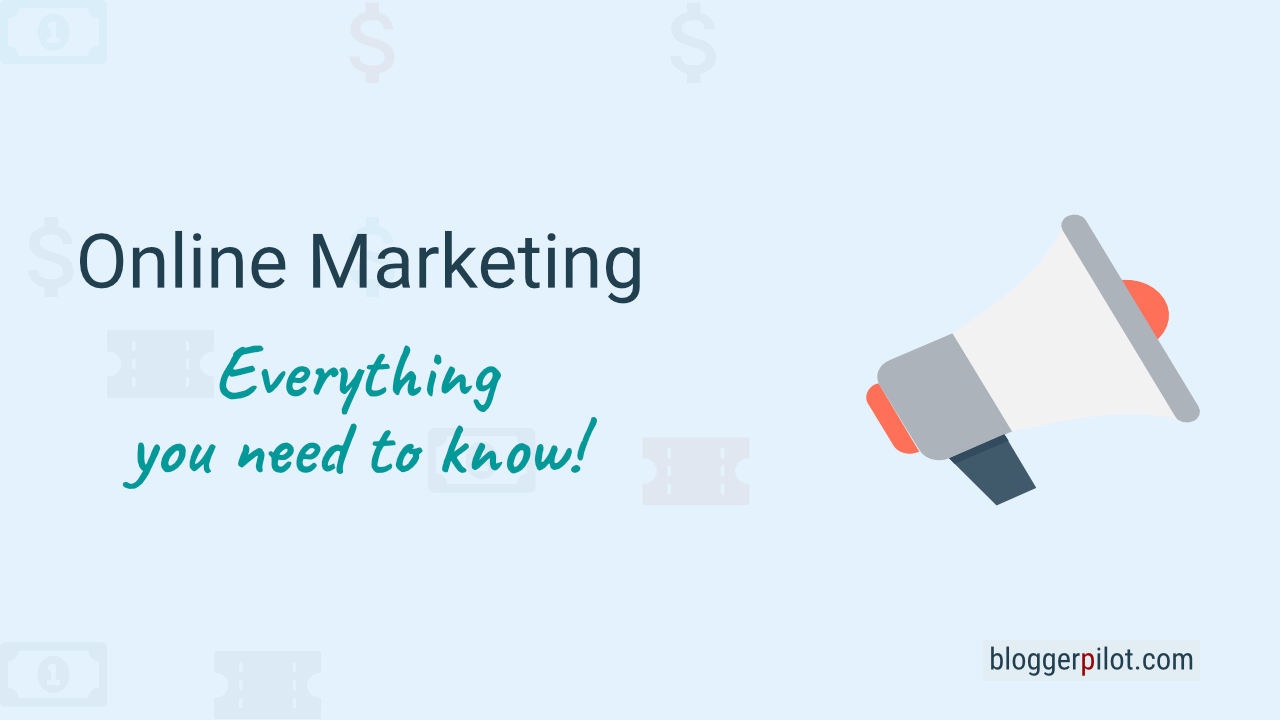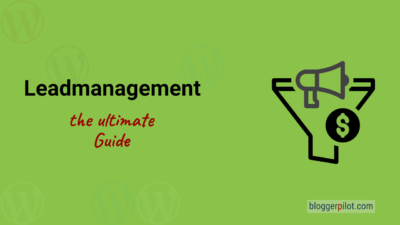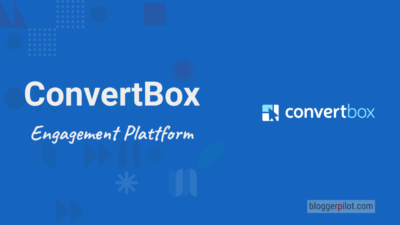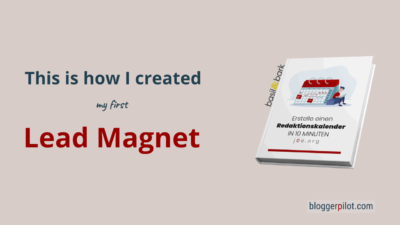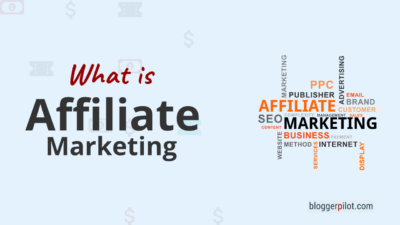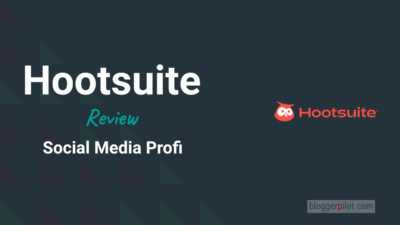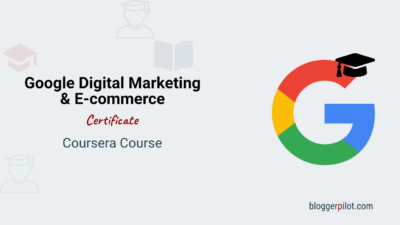Online-Marketing: Overview of the Specifics of Internet Marketing
My ultimate guide to online marketing! Nowadays, many people can’t imagine life without the Internet. They use social media every day to watch news and videos, or to catch up with friends and family. And who hasn’t searched online for products or information? The fact is: the World Wide Web is indispensable and it is also more than relevant in marketing.
Online marketing, also known as Internet marketing, includes every measure (e.g. content marketing) that companies use to reach (potential) customers online. Popular channels include websites, search engines and social networks. Proven tools include journey maps and marketing funnels.
Online marketing (also called Internet marketing or digital marketing ) reaches people exactly where they spend the most time: on the web.
Social media can be used to reach millions of people. Products and services can be presented without intrusive advertising measures. So anyone who doesn’t do online marketing is at a clear disadvantage. But what exactly is online marketing, and how does it work? What tools and channels are there? I’ll answer these and other questions here.
Definition: This is online marketing / Internet marketing
Online marketing includes all marketing activities of a company that are carried out via the Internet. These can include branding, customer acquisition, or the sale of products and services.
Now again without any theoretical blah blah: What is online marketing or internet marketing?
Simply put, it’s everything your business does online to attract the attention of potential buyers and encourage them to buy something from you. The idea here: to build a connection online between the buyer and your business so that your brand becomes recognizable and established in the digital world.
With increasing digitalization, new techniques and tools for online marketing are constantly being developed – internet marketing is always relevant. Companies either have their own in-house online marketing managers or work with online marketing agencies.
Meanwhile, sales and marketing simply belong together. This means that for a successful customer journey, both departments must function as a team. But more on this later.
That’s why you shouldn’t do without online marketing:
- Information about consumers helps you to adapt your offer to the wishes and preferences of your customers.
- The lasting and qualitative contact strengthens customer loyalty.
- You can do online marketing even with a small budget.
- You can improve your brand image and quickly increase your brand awareness.
Online marketing is all about identifying and serving customer needs. Provide potential customers with a positive user and customer experience! Online marketing is versatile and can consist of very different focal points. I’ll tell you what they are and how to approach them properly.
Marketing measures for your marketing strategy
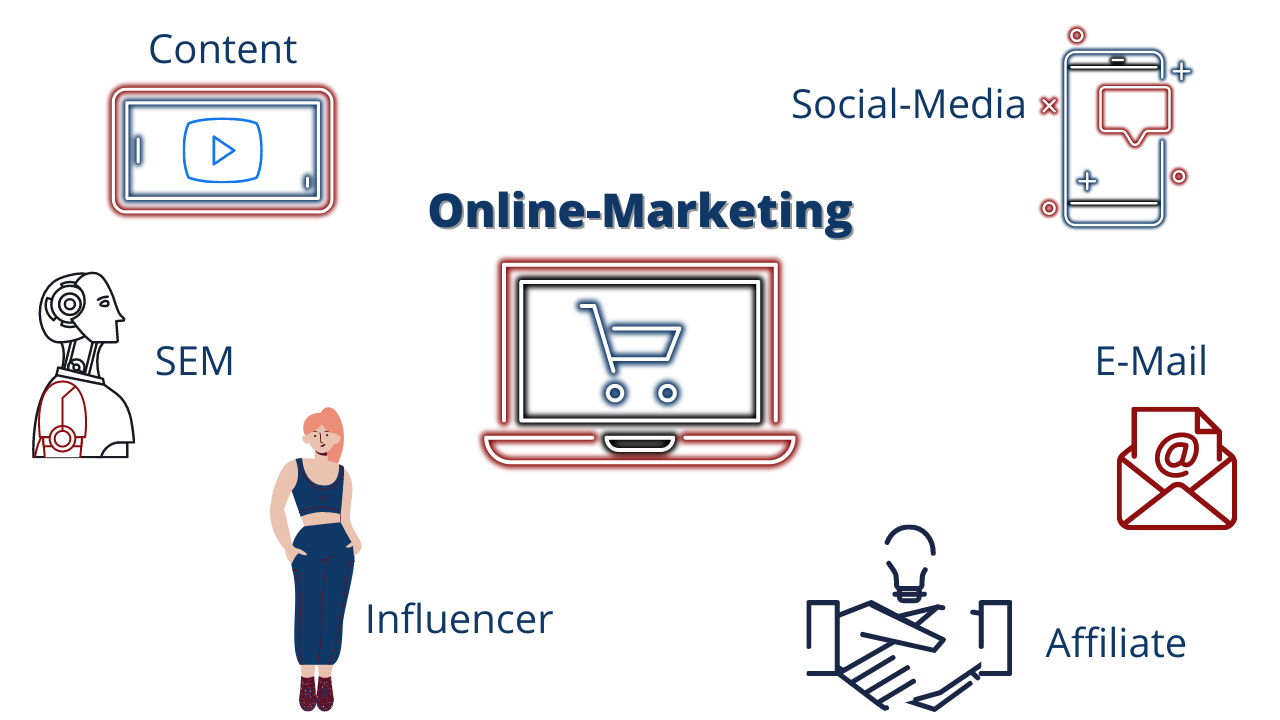
If you want to be successful, you need a decent marketing strategy and you have to implement it purposefully.
You can reach into a large toolbox to implement your marketing strategy. Your tools can be online marketing, offline marketing or even press relations. In this article, we will focus on online marketing.
1. The specifics of search engine marketing (SEM)
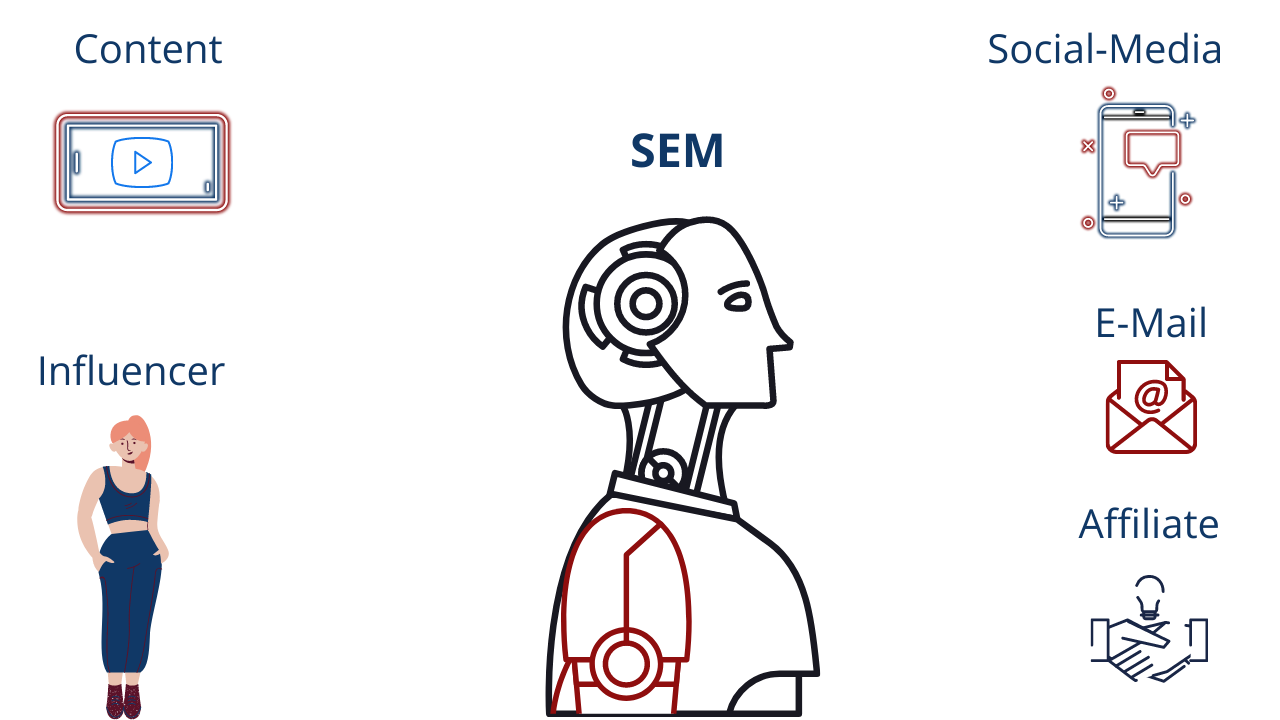
What is SEM?
Your website is your digital business card. It decides about the first impression your website visitor gets of you and your offer.
A successful website requires more than commitment alone: Often entrepreneurs put a lot of work into the creation of their website, but it is hardly called up. This is usually due to a lack of search engine marketing (SEM).
SEM refers to the technical part of your marketing strategy that is relevant to search engines. Of course, it’s ultimately about people Googling something, but search engines need to understand and rank your website as appropriate to display to relevant people.
SEM functions and goals:
- Lead generation: reaching the people who have a need for your solutions.
- Increased traffic (= more visitors): If your website/ad makes it to the top 10 search results, you’ll get a lot more clicks and visitors.
- Outperforming competitors: If you achieve a top position in the search engines, you increase your competitiveness.
- Increase brand awareness: You increase your visibility on the web. Even if Internet users don’t click directly on your link, your company will remain in their memory.
Basically, there are two ways to achieve these goals:
- Paid advertisements (SEA)
- Organic, unpaid traffic (SEO)
SEA: Search Engine Advertising
SEA (Search Engine Advertising) is a targeted search engine advertising. You thus place paid ads via a search engine (e.g. Google) or via social media. The best-known form of SEA is probably called Google Ads.
If you enter a certain search query on Google, you will notice that so-called paid results (“ads”) appear at the top of the search engine. That’s exactly what these purchased ad placements are.
The special feature of search engine advertising: results are only displayed when someone searches for certain terms. These are also called keywords. You can buy these keywords through auctions, for example. If your bid is high enough, your ad will appear for Internet users when they search for the specific keywords.
You should keep this in mind:
Think carefully about which payment model best suits your ad. Pay-per-click is commonly used for Google Ads. It decides in real time whether your ad will be placed under specific search queries.
You search for different keywords that match your website, products or services. Since ad space in search results is limited, prices for different keywords are calculated in a real-time bidding process based on factors such as search volume and popularity among other bidders. The price is then calculated per user click on your ad.
Google Ads’ Keyword Planner can be used to determine advertising costs, as it displays estimated PPC values. However, you should note that Google Ads now also uses other payment models, such as cost-per-view (CPV) for video ads, so it is not limited to PPC.
Another payment model is cost-per-impression, abbreviated as CPI. Here, it depends on the website calls (ad impressions). For each website call, the website provider (i.e. you) is charged a certain amount. It does not matter whether the user has actually clicked on the ad in question. Payment is made for each individual display of the ad.
Functions and goals of SEA:
One of the main goals of SEA is to increase your click-through rate by placing ads. You can easily reach your target audience and gain more users as customers. SEA can prove to be an especially important part of a strong online presence.
SEO: Search Engine Optimization

SEO is search engine optimization and is derived from Search Engine Optimization. It ensures that search engines automatically consider your website as particularly relevant and recommendable. This way you appear high up in the search results without having to spend money on ads.
The ranking is based on keywords, visitor numbers, videos, images and links, among other things. At the same time, SEO marketing aims to target the audience that is really interested in your product or service. This group of people should show active interest in your website. Website visitors can interact with your content, for example, by leaving comments or signing up for your newsletter. Even if they don’t buy your offer right away.
Here’s what you should keep in mind:
- The technology must work: This means all technical aspects of your website. It should always be up to date. Because long loading times or poor performance lead to a poor user experience and discourage users. This is not only noticed by the users, but also by the search engines.
- Content: Content includes text, images and videos on your website. Content must be relevant, unique, original, and “fresh,” meaning it must be updated as necessary.
- Popularity: People link to content on their own websites or social media profiles that they find interesting and helpful. This creates link building. Links are like recommendations and create trust among people and machines. In SEO, these links are also called backlinks. They signal to search engines like Google that your content is popular and help your website rank better.
Functions and goals of SEO:
The main goal, as mentioned earlier, is to achieve top positions in search results. However, depending on your website, there may be other goals as well:
- Increase your brand awareness
- Increase your reach
- Increase traffic
- Oust competitors
- Increase sales and leads
If you want to dig deeper, be sure to read why SEO optimization is so important for business websites.
You’re aware of the benefits SEO can bring you, but want a little help getting started? Then you shouldn’t miss my article on OnePage optimization. You can also use this article as a template for regular optimization.
In fact, there is a video series that clarifies common SEO misconceptions and addresses the most important questions around search engine optimization. Here you can find my articles about SEO that might be of interest to you.
Local-Search-Engine-Optimization (Local-SEO)
Imagine you want to bring your team to the table with a delicious family pizza. What do you do to find a restaurant? You probably look it up on the Internet and you’re immediately shown results near you.
But how does it actually work that you find online so quickly, suitable providers and relevant information such as opening hours or menus, you have not even specify a location?
Loca-Search-Engine-Optimization (Local-SEO) is another part of search engine marketing and refers to the location of your business. Local-SEO is designed to place local and regional businesses at the top of search results.
Goals of Local-SEO are:
- Identical to the goals of search engine optimization.
- This is to increase presence in local search results.
Is SEA or SEO better?
Basically, SEA and SEO are complementary. Both measures have the purpose that as many people as possible come to your website. However, SEO is a slow process in comparison, where you don’t get instant results. It takes time to rank a website for different keywords and achieve a high position in the search engines. SEO is sustainable for this and there is no cost for ad placement.
What about your industry? Your competitors will probably be trying just as hard to position themselves well. If you have the opportunity to work diligently with SEO, your business will benefit in the long run. Your website can grab a top position in search results inexpensively.
If you rely on quick results, SEA may be a better choice. The downside is that once you stop investing in ads, the traffic will decrease. In addition, you must always consider whether SEA is actually worthwhile for you and whether the costs incurred are acceptable. Depending on which keywords you choose, the costs for the ads can be quite high. Many companies opt for a combination of SEO and SEA.
2. The specifics of content marketing
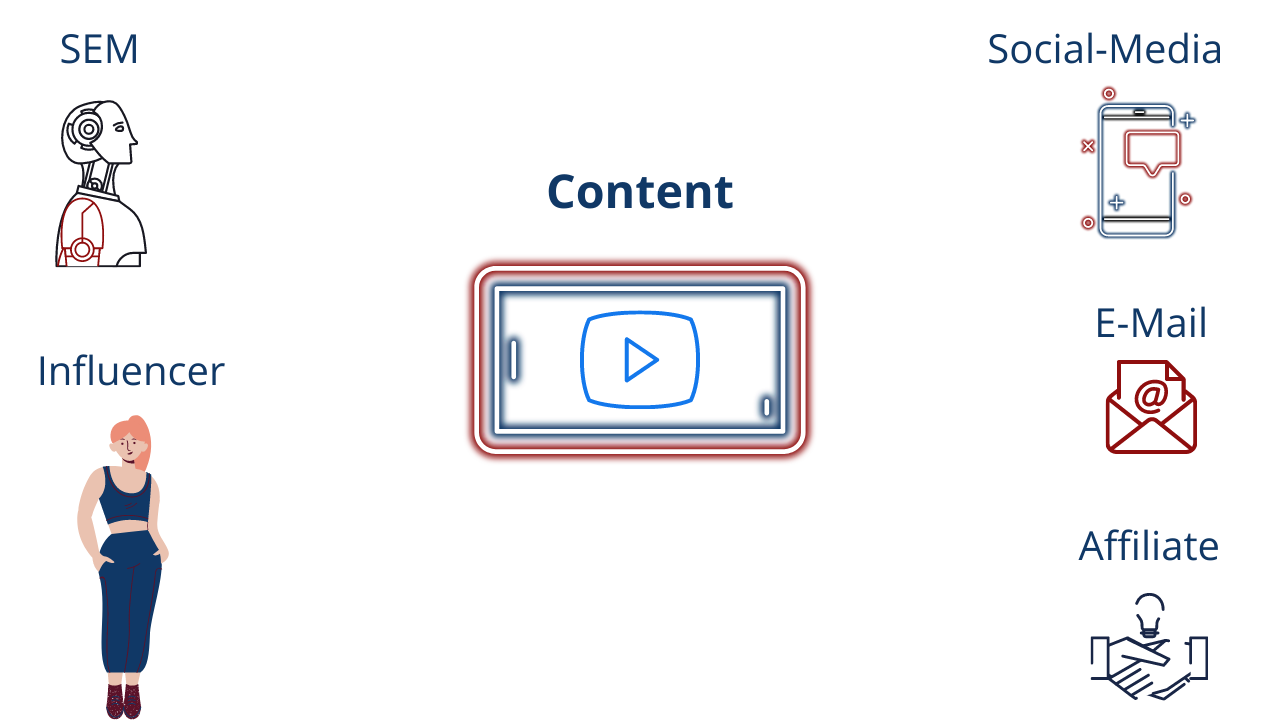
What is most likely to attract your customers, leads and visitors? Good content, of course. Helpful, relevant and in the best case still free of charge – that convinces! Content marketing can be informative, consultative and entertaining. This content can consist of texts, images or videos. Typical elements are blog posts, infographics, e-books and newsletters. Effective content marketing turns your visitors into real followers and improves your brand awareness, because they will recommend you to others.
Examples of content marketing efforts:
- YouTube videos
- How-to clips
- Guides and tutorials
3. The specifics of affiliate marketing
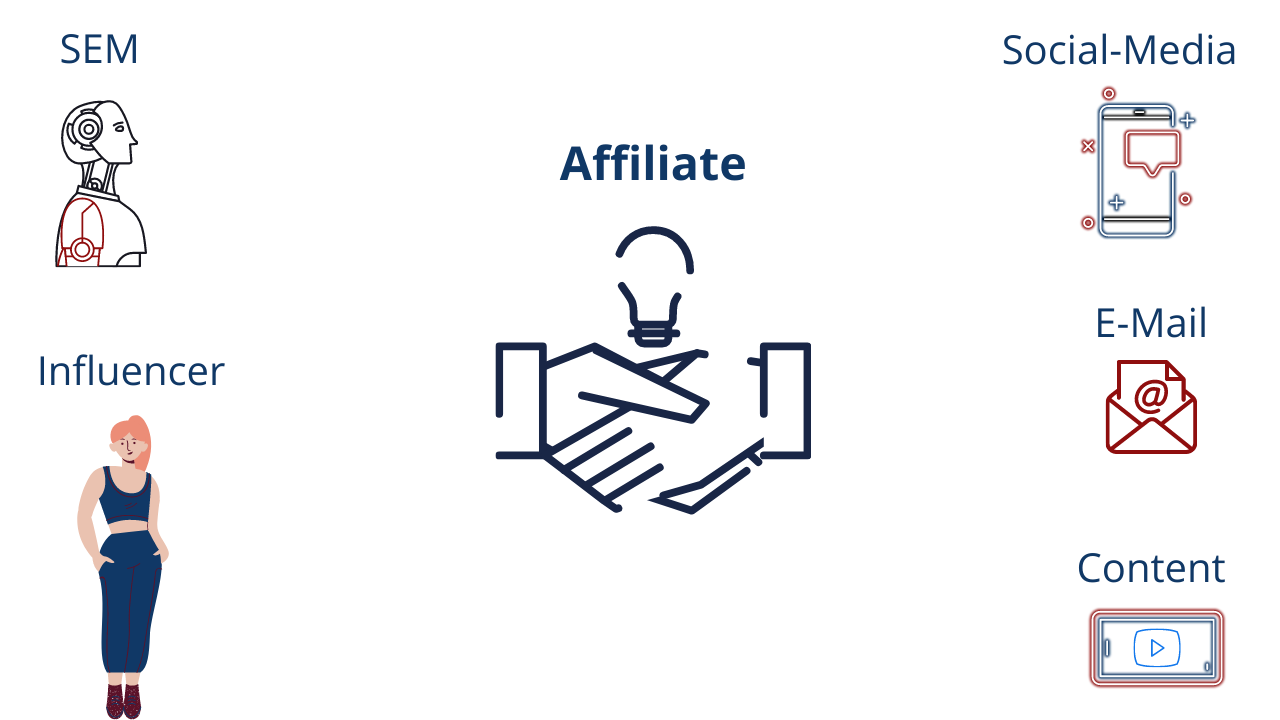
The saying “Teamwork makes the dream work” is there for a reason. With the right partner, you can accomplish more than you can alone – and both benefit. Affiliate marketing makes it possible.
Basically, affiliate marketing is nothing more than a partnership between a company and a partner (affiliate). The partners place links with services and products of the company on their websites, social media, search engines or emails and receive a commission for this.
You’ve probably come across affiliate marketing on YouTube more than once. The most successful video categories there are product reviews, tutorials and top lists. Studies showed that 68% of users have watched a video to make a purchase decision. Therefore, there is an increased probability that they will also click on affiliate links available there.
Payment in affiliate marketing is made according to different models. It is paid per click, lead or sale. So also according to the “cost-per” model. You want to know more? This is affiliate marketing and this is how you can make money online with it.
4. The specifics of email marketing

Who doesn’t know it, before you can really start your day, you first have to check your emails. Work-related, or to check when your package will finally arrive – it’s just part of the day. Take advantage of it – you too can reach (potential) customers through email.
In email marketing, contacts are contacted directly via an email tool and provided with the latest offers. Each email serves to build customer and brand loyalty, as well as trust. We distinguish:
Transactional emails
Transactional emails are emails with technical content that are automated by specific business transactions or visitor actions. Unlike newsletters, they are independent emails that are sent based on a specific action by the recipient. They can be triggered by an order, for example. Typical are shipping and delivery confirmations or password changes.
E-mail newsletters
Email newsletters differ from transactional emails. They can be sent to both existing contacts and potential new customers. Do newsletter subscribers increase the likelihood of making a purchase more easily than other prospects? Find out here whether email marketing and newsletter marketing are worthwhile for you!
5. The specifics of social media marketing
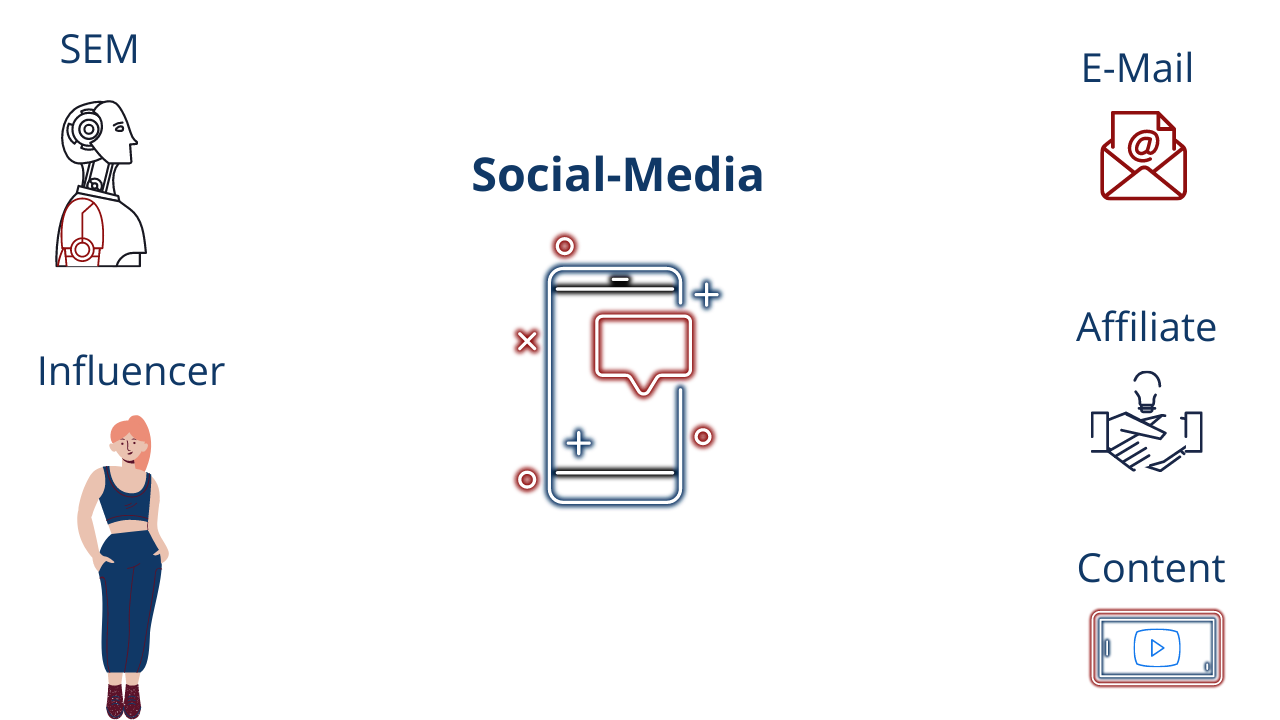
In the past, consumers became aware of products and services through media such as newspapers, the television or the radio. But in times of digitalization, these channels hardly work anymore. In addition, there are the large scattering losses. So how do you find access to your target group? In most cases, social media marketing is a particularly good way to do this, because there is hardly a target group that doesn’t bustle around in one or more social networks.
The big difference between social media marketing and other marketing channels is interaction. The prospect remains passive with a TV ad or billboard, but on social media he can comment, share or send messages with just one click.
Moreover, users connect with the brand every day in their daily lives when they are on social media. A bond with the brand is built and strengthened. The result: a community of your own is created around your company. Want to know more about social media marketing? Find out how social media marketing works here!
Display advertising
Whether via popups, banners or content ads, no one can avoid display advertising on the Internet. That’s exactly why this form of advertising is becoming increasingly important. According to Google, the Google Display Network reaches around 90% of Internet users worldwide via millions of websites, blogs, YouTube and Gmail.
Display advertising refers to all graphic advertising media such as videos, animations or images that promote your product or service. The goal is to increase your reach and make your brand better known. Through display advertising, Internet users come across your company while they are on Facebook, opening an app, or watching videos on YouTube, for example.
6. The specifics of influencer marketing
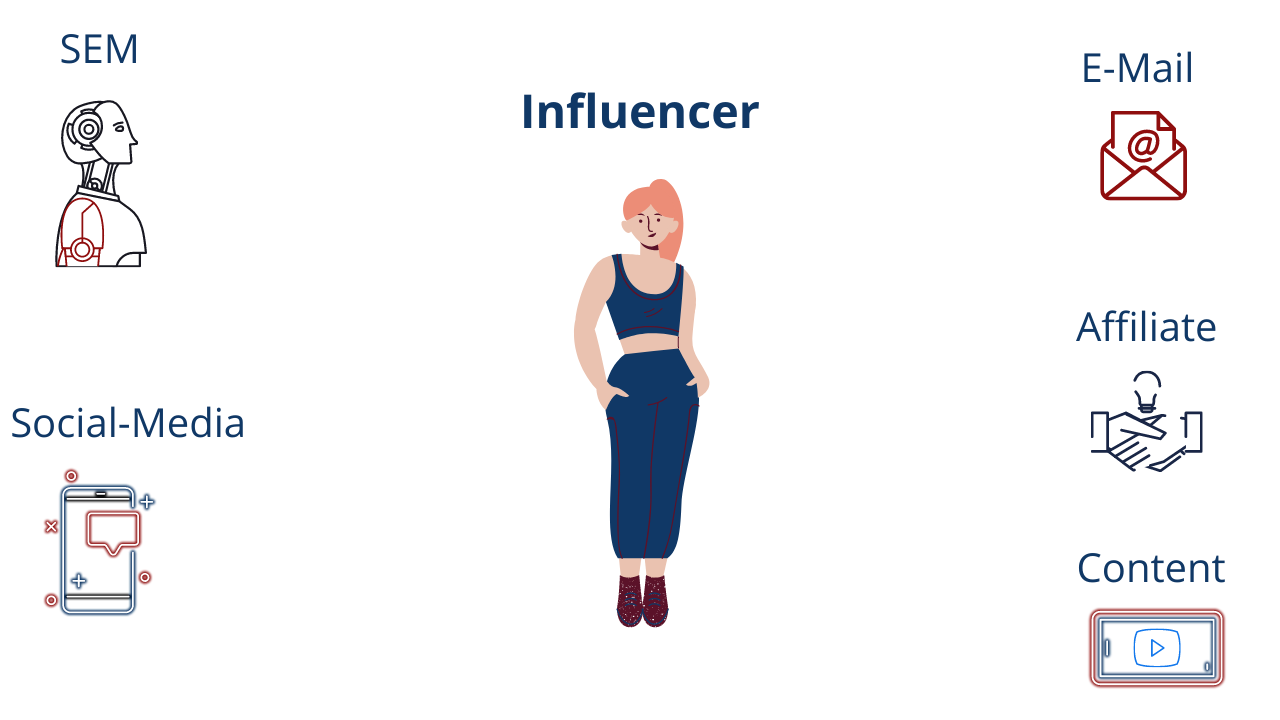
What is an influencer?
To understand influencer marketing, it is important to first understand what influencers are. Is it a famous person? A person with many followers on social media? Someone who sells products? To all these questions, the answer is “not necessarily”.
An influencer is a person who, because of their personality and social skills, has a great influence on the opinions and decisions of others. These characteristics are ideal for companies to draw attention to their products through influencers, as they have a high reach and people trust them. So, if an influencer recommends your product or service, you don’t have to earn the prospect’s trust first.
How does influencer marketing work?
When Kim Kardashian holds a perfume up to the camera on Instagram and tells you how great she thinks it is, that’s influencer marketing. Companies are leveraging the reach, image and influence influencers have on their followers.
Mobile advertising
Mobile advertising describes the overall concept of all communicative advertising measures between customer and company on mobile devices such as smartphones and tablets. Companies advertise with text ads via SMS or with banner ads embedded on a mobile website. Advertising is tailored to the consumer using data mining and other information-gathering techniques, such as capturing their search history.
Types of mobile advertising
Mobile advertising can run across a variety of forms and platforms. Social media platforms function differently:
- Push notifications: These are popups that appear on a mobile device. These can be displayed to users even if they are not on the associated app.
- Image texts and banner ads: Users who click on these types of ads will be redirected to your site as a result.
- Click-to-download ads: When a consumer clicks on these ads, they are redirected to the Google Play or app store. Depending on which cell phone the user owns.
Lead generation in online marketing
More About Lead Generation:
Lead generation in online marketing is about identifying qualified leads and converting them from visitors into customers. There are several ways to do this:
Websites and blogs in online marketing
Blog articles are good for drawing more attention to your website. By writing relevant articles that answer your target audience’s questions and pique their interest, readers will turn into qualified leads in no time.
Classify and retain leads through online seminars
An online seminar is the equivalent of an in-person seminar. Since they require registration, you can use them to gather information about attendees. The key to a successful online seminar is to choose topics that your target audience will find interesting. It should represent a solution to their acute problem. Over time, attendees will trust your business and be more likely to buy something from you as a result. Especially in the high-priced sector and in the healthcare industry, trust plays a crucial role.
Social media as a lead source in online marketing
There is hardly any place where you can find as many prospects as on social media. Through online platforms, you can get their contact information. Offer delightful, free products in exchange for them giving up their email. Plus, on social media platforms like Facebook and Instagram, you have access to powerful tools to run ads to reach specific audiences. Successful B2B markets often use paid Facebook and Instagram ads to drive traffic to their gated content.
Whitepapers in internet marketing
Whitepapers are one of the most common ways to generate leads – especially in the B2B sector. You can offer it on your website. Whitepapers are also great for pay-per-click offers. The e-book usually has more content than a whitepaper, but serves a similar function. If your e-book covers a topic in great detail and adds a lot of value, it can attract a lot of attention and build your reputation.
Strengthen loyalty with e-mail marketing via newsletters
You can provide your customers and leads with your new offers via newsletters. On your website, be sure to include an easily accessible newsletter signup if you want to do effective email marketing.
Want the details? Get more practical tips and information about lead generation.
The most important online marketing tools

In the world of digital marketing, competition is fierce. To keep up and stand out, you can’t do without the right tools. The more you know about what online marketing tools to have, the better your business will stand. According to OMR Reviews, here are the 10 best tools.
Trello
Trello is great for brainstorming ideas and forwarding tasks to other departments and colleagues. You can also share all campaign pieces, such as ads and copy, with your staff to get feedback before publishing the content online. Trello can be used as a central hub for any marketing efforts in your company.
MailChimp
MailChimp is one of the most used newsletter tools. This online marketing tool has various features for email marketing and creative content. You can use it to create newsletter campaigns that are automatically played out to new contacts. With MailChimp, all activities can be measured and analyzed, so you can target your audience even better.
Hubspot Marketing Hub
HubSpot Marketing Hub is a marketing hub. It automates email marketing, online marketing, and lead management. The dashboard is clear and the tool is generally very user-friendly. HubSpot also offers other tools to drive automation in sales and customer service.
Canva Pro
Canva Pro helps with content creation. This online marketing tool offers a variety of photos, videos, graphics, and audios. You can create content for your social media strategy that fits your target audience. Canva Pro is especially good for you if you’re not particularly familiar with Photoshop and the like. You don’t have to be a pro to understand how to use it, it’s pretty simple and high quality.
Hootsuite
With Hootsuite you can easily manage the accounts, messages and community on your social media channels. You can use it to create social media post, schedule them and analyze your performance afterwards.
Google Analytics
Google Analytics effectively analyzes your website. With this tool, you can see how high the traffic and engagement is and how long users stay on your website. Additionally, there is an Analytics app that gives you mobile insight into your website numbers.
Kissmetrics
This online marketing tool analyzes the behavior of your customers. The funnel report shows you how your visitors became actual customers and who bounced. It helps you to adjust your online marketing campaign in a targeted way.
SemRush
With the keyword explorer of SemRush you can find out which search terms are well received in your area. In addition, you can select successful content, perform competitive analyses and use the site audit to find out which optimizations you can still implement for your website.
CreatorIQ
This online marketing tool helps your marketing team or agency find influencers and build a relationship. As well as with the concrete campaign management and measuring the results. Channels currently represented in the platform include Instagram, YouTube, TikTok and Snapchat. In addition, topics such as payment processes, contract management or paid media can be mapped through CreatorIQ.
MessengerPeople
With MessengerPeople, you can quickly communicate with your customers and prospects. The software is DSGVO compliant and works for WhatsApp, iMessage and some other messenger apps. MessengerPeople has more features ready, including chatbots, text modules or Messenger newsletters.
Online marketing strategy: what is it and how do you apply it?

Professional online marketing starts with a well thought-out online marketing strategy. In simple terms, this strategy describes what you want to achieve in terms of online marketing and, most importantly, how. To develop a good online marketing strategy, you should follow these important steps:
Develop your buyer persona

A prerequisite for an effective marketing strategy is that you know exactly who your target audience is. Therefore, you should first create your persona. Roughly speaking, a buying persona is a fictional person who represents your typical customer. This concept makes it easier for you to better understand your ideal customer’s needs, challenges, and behaviors. Buyer personas can be based on data from existing customer analytics. This will help you flesh out your persona and better tailor your offering to your customers.
Define your goals
After you’ve taken a close look at the profile of your ideal customer, you should define concrete marketing goals. Think about what you want to achieve and how you will get there.
Once you’ve set long-term goals for growth and development, it’s important to make sure your strategy promotes and supports those goals. Using the “SMART” method can help you set effective marketing goals:
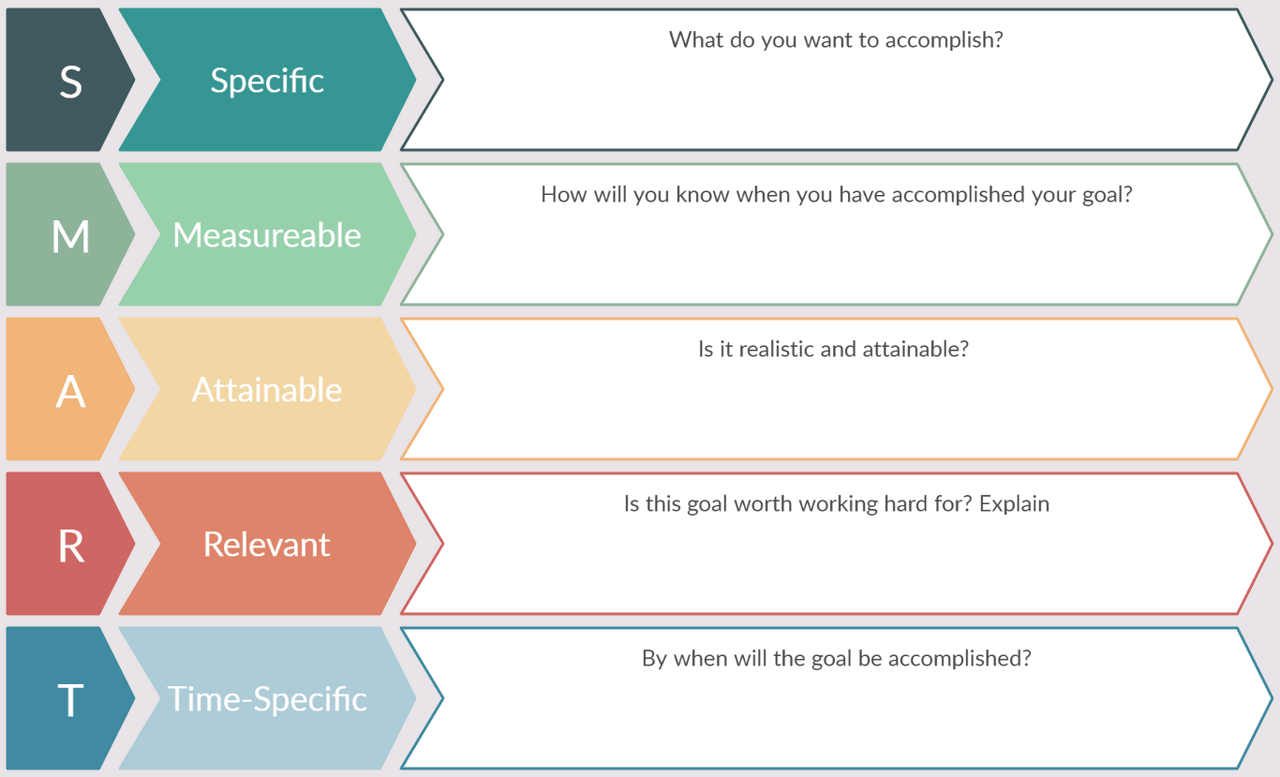
- S (Specific): Describe exactly what goals you want to achieve, the more detailed the better.
- M (Measurable) Think about what criteria are necessary to measure your success.
- A (Attainable) Your goals should be in line with the needs and image of your company.
- R (Relevant) Make sure your goals are realistic and achievable.
- T (Time) A clear deadline by which the goals should be achieved makes your plans more concrete.
Review and improve permanently
Even after you’ve implemented your strategy, there’s another step. The key to an effective online marketing strategy is to evaluate your strategy to see how effective it is and adjust it if necessary.
Once you’ve executed the strategy, you should record all of the weekly and monthly results. This will help you see which techniques are working well and which marketing efforts should be touched up.
Online marketing mix: using the right ingredients for success
Salt is great, but too much salt can spoil the dish. It’s just as important in your marketing plan to find the perfect balance: This is where the marketing mix comes into play.
With the marketing mix, you translate your marketing strategies and plans into concrete actions that lead to successful marketing of your products. The cornerstone of the marketing mix is the “4 P’s”. They originate from the English language and stand for:
- Product (product policy)
- Price (pricing policy)
- Place (distribution policy)
- Promotion (communication policy)
Product (product policy):
Not only your target group is crucial! The product is the basis of the marketing mix and should not be neglected.
The product policy concerns all processes that deal with the selection, development and marketing of the product. It is mainly about clarifying questions around the characteristics of your own products. What quality should it have? Depending on the attributes, prices will be set later. Do you want to offer product variations? Let’s say you want to offer different types of drinks. Then you should make the decision depending on the demand and chances of profit. What should the design look like? The materials for packaging and presentation must also be well thought out. The colors and packaging should match the image of your brand and be appropriate for your target audience.
Price (pricing policy):
Price is almost as important as the product in the marketing mix. And this is exactly what the pricing policy deals with. This area includes product price, financing options, payment and delivery terms, and discounts.
The challenge in pricing policy is to find a price that sounds good to consumers, but at the same time brings profit. Consumers prefer to buy a product that is 9.99 euros instead of 10 euros. What’s the reason for that? The price looks more attractive. To get the optimal price, you should consider manufacturing costs, material and production costs, supply and demand, and competitors’ prices, among other factors.
Place (distribution policy):
How does your product get to the customer? This is the central question in distribution policy, or sales policy.
In this area it is about getting your product to your customer at the right time, at the right place. The task of distribution policy is to decide whether the product should be sold directly to your customers or through a wholesaler or retailer. You have to make decisions about distribution channels, logistics issues and your choice of location. Another factor is to determine whether your product should be distributed regionally, nationally or internationally.
Promotion (communication policy)
Communication policy refers to all communication measures that arise as a result of marketing.
These include advertising campaigns, PR, sponsorship and marketing campaigns. They are intended to draw attention to your products and encourage the target group to buy or improve the image of your company.
Tracking in online marketing
Tracking in online marketing is an important part of any marketing strategy. It helps companies understand their website visitors and optimize their marketing campaigns. Tracking tools can be used to collect data about the number of website visitors, the pages they visit, the time they spend on the site, and the actions they take. This data can then be used to improve website performance, segment audiences, and create personalized content and offers.
The future of online marketing
“People store and learn completely differently than they did a few years ago. That’s why marketers need to adapt or risk going under.”
Brian Halligan, CEO
Digital marketing has taken the business world by storm. As the Internet has become an integral part of our everyday lives, business marketing has completely changed as well. These days, there’s hardly anything that isn’t advertised on the web. Clothes, food to hotels – with one click you can find everything there.
Modern technologies such as AI (artificial intelligence), AR (augmented reality) and virtual reality are becoming increasingly relevant in online marketing. From voice search and Amazon Go to chatbots, AI is changing the face of the digital landscape. Through effective data analytics, AI can take over more and more time-consuming tasks.
More and more brands and marketers are using automated digital marketing services to save time and resources. Now, when AI is combined with visual technologies like AR and VR, it creates an entirely new experience for customers. This strategy offers them unique opportunities to discover companies in previously unknown ways. The combination of AI and AR/VR not only refreshes the user experience, but also creates a distinctive brand identity, leading to greater customer loyalty.
Artificial intelligence helps companies evolve and make their work at the same time, easier and more enjoyable. You could call AI the future of digital marketing.
Tip: Become a professional with the Digital Marketing Certificate from Google.
Conclusion on online or internet marketing
Successful companies have one thing in common: they move with the times and use online marketing.
Digitization is simply everywhere. Billions of messages are spread every day through social media and search engines. The Internet is also inescapable for businesses. Due to the ever-increasing user activity, online marketing activities are becoming more versatile and important.
You or your company should also be found on the web. Being future-oriented and showing willingness to change are the keys to staying relevant and interesting for your target group.
